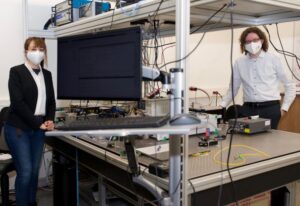Chromatic light particle effect revealed for the development of photonic quantum networks

The graphic visualises quantum mechanical interference, also called the Hong-Ou-Mandel effect: A yellow and an orange photon hit a frequency mixer (white bar) from the right and emerge always together in the same color, here two yellow photons.
Image source: Michael Kues/Anahita Khodadad
Researchers demonstrate a novel photonic interference effect that could pave the way to large-scale controllable quantum systems

Photo source: Sonja Smalian/PhoenixD
It’s another step on the road to developing quantum information processing applications. A key experiment succeeded in going beyond the previously defined limits for photon applications. Anahita Khodadad Kashi and Prof. Dr. Michael Kues from the Institute of Photonics and the Cluster of Excellence PhoenixD at Leibniz University Hannover (Germany) have demonstrated a novel interference effect.
The scientists have thus shown that new colour-coded photonic networks can be tapped, and the number of photons involved, i.e. light particles, can be scaled. “This discovery could enable new benchmarks in quantum communication, computational operations of quantum computers as well as quantum measurement techniques and is feasible with existing optical telecommunication infrastructure,” says Kues.
The decisive experiment was successfully performed in the newly established “Quantum Photonics Laboratory (QPL)” of the Institute of Photonics and the Hannover Centre for Optical Technologies at Leibniz University Hannover. Anahita Khodadad Kashi succeeded in quantum-mechanically interfering independently generated pure photons with different colours, i.e. frequencies. Khodadad Kashi detected a so-called Hong-Ou-Mandel effect.
Hong-Ou-Mandel interference is a fundamental effect of quantum optics that forms the basis for many quantum information processing applications – from quantum computing to quantum metrology. The effect describes how two photons behave when they collide on a spatial beam splitter and explains the phenomenon of quantum mechanical interference.
The researchers have now realised a frequency beamsplitter using telecommunications components and demonstrate the Hong-Ou-Mandel effect for the first time between two independently generated photons in the frequency domain. In contrast to other dimensions, such as the polarisation (oscillation plane of the electric field) or the photon’s position (spatial localisation), the frequency is much less susceptible to interference. “Our approach allows flexible configurability and access to high-dimensional systems, which may lead to large-scale controllable quantum systems in the future,” says Kues. This two-photon interference phenomenon can serve as a foundation for a quantum internet, non-classical communication and quantum computers. In other words, the results could be used for frequency-based quantum networks. Another notable feature of the new discovery is that this increase in performance could be used with existing infrastructure, i.e. standard fibre optic connections for connecting to the internet. The use of quantum technologies at home could thus theoretically be made possible in the future.
“I was very pleased that our experiment was able to demonstrate the Hong-Ou-Mandel effect in the frequency domain,” says Khodadad Kashi. The researcher moved to Hannover in 2019 after completing her master’s degree in electrical engineering, focusing on photonics at Iran University of Science and Technology in Tehran. Since then, she has strengthened Prof. Kues’ team of seven. Kues has been a professor at Leibniz University Hannover since spring 2019 and is researching the development of photonic quantum technologies using micro-and nanophotonics in the Cluster of Excellence PhoenixD. In the future, Kashi and Kues will continue their research on the topic of spectral Hong-Ou-Mandel interference. “I would like to extend the current experiment to exploit the demonstrated effect for quantum information processing,” says Khodadad Kashi.
The scientific journal “Laser & Photonics Reviews” publishes the research results first. The research was part of the Quantum Futur project “PQuMAL” (Photonic Quantum Circuits for Machine Learning) funded by the German Federal Ministry of Education and Research (BMBF).
The PhoenixD Cluster of Excellence
Between 2019 and 2025, the Cluster of Excellence PhoenixD led by Leibniz University Hannover will receive approximately 52 million euros of funding from the federal government and the State of Lower Saxony via the German Research Foundation (DFG). The cluster is a collaboration of TU Braunschweig, Max Planck Institute for Gravitational Physics (Albert Einstein Institute), Physikalisch-Technische Bundesanstalt and Laser Zentrum Hannover e.V. Within the scope of the cluster, more than 100 scientists from the fields of physics, mechanical engineering, electrical engineering, chemistry, computer science and mathematics conduct interdisciplinary research. The cluster explores the possibilities offered by digitisation for novel optical systems as well as their production and application. Further information: http://www.phoenixd.uni-hannover.de
Original article
Anahita Khodadad Kashi, Michael Kues,
Spectral Hong-Ou-Mandel interference between independently generated single photons for scalable frequency-domain quantum processing,
Laser & Photonics Reviews
https://doi.org/10.1002/lpor.202000464
Note to editors:
The researcher is available for interviews. Please contact:
Prof. Dr Michael Kues holds a professorship at the Institute of Photonics and is a member of the PhoenixD Cluster of Excellence at Leibniz University Hannover. Phone +49 511 762 3539,
Email: michael.kues@iop.uni-hannover.de
Media Contact
All latest news from the category: Physics and Astronomy
This area deals with the fundamental laws and building blocks of nature and how they interact, the properties and the behavior of matter, and research into space and time and their structures.
innovations-report provides in-depth reports and articles on subjects such as astrophysics, laser technologies, nuclear, quantum, particle and solid-state physics, nanotechnologies, planetary research and findings (Mars, Venus) and developments related to the Hubble Telescope.
Newest articles

An Endless Loop: How Some Bacteria Evolve Along With the Seasons
The longest natural metagenome time series ever collected, with microbes, reveals a startling evolutionary pattern on repeat. A Microbial “Groundhog Year” in Lake Mendota Like Bill Murray in the movie…

Witness Groundbreaking Research on Achilles Tendon Recovery
Achilles tendon injuries are common but challenging to monitor during recovery due to the limitations of current imaging techniques. Researchers, led by Associate Professor Zeng Nan from the International Graduate…

Why Prevention Is Better Than Cure—A Novel Approach to Infectious Disease Outbreaks
Researchers have come up with a new way to identify more infectious variants of viruses or bacteria that start spreading in humans – including those causing flu, COVID, whooping cough…



